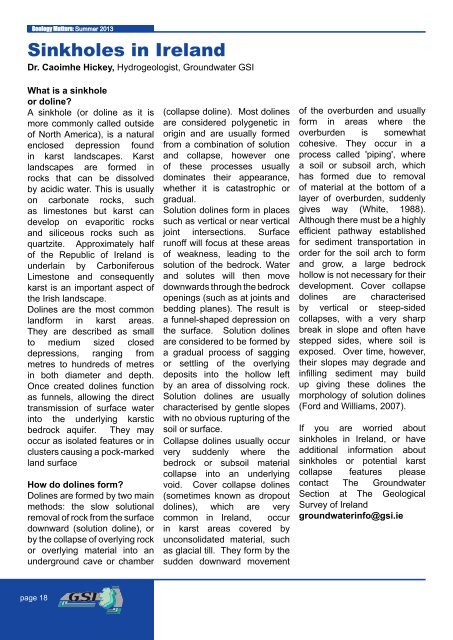Sinkholes Tellus Border Earthquake - Geological Survey of Ireland
Sinkholes Tellus Border Earthquake - Geological Survey of Ireland
Sinkholes Tellus Border Earthquake - Geological Survey of Ireland
Create successful ePaper yourself
Turn your PDF publications into a flip-book with our unique Google optimized e-Paper software.
Geology Matters: Summer 2013<br />
<strong>Sinkholes</strong> in <strong>Ireland</strong><br />
Dr. Caoimhe Hickey, Hydrogeologist, Groundwater GSI<br />
What is a sinkhole<br />
or doline?<br />
A sinkhole (or doline as it is<br />
more commonly called outside<br />
<strong>of</strong> North America), is a natural<br />
enclosed depression found<br />
in karst landscapes. Karst<br />
landscapes are formed in<br />
rocks that can be dissolved<br />
by acidic water. This is usually<br />
on carbonate rocks, such<br />
as limestones but karst can<br />
develop on evaporitic rocks<br />
and siliceous rocks such as<br />
quartzite. Approximately half<br />
<strong>of</strong> the Republic <strong>of</strong> <strong>Ireland</strong> is<br />
underlain by Carboniferous<br />
Limestone and consequently<br />
karst is an important aspect <strong>of</strong><br />
the Irish landscape.<br />
Dolines are the most common<br />
landform in karst areas.<br />
They are described as small<br />
to medium sized closed<br />
depressions, ranging from<br />
metres to hundreds <strong>of</strong> metres<br />
in both diameter and depth.<br />
Once created dolines function<br />
as funnels, allowing the direct<br />
transmission <strong>of</strong> surface water<br />
into the underlying karstic<br />
bedrock aquifer. They may<br />
occur as isolated features or in<br />
clusters causing a pock-marked<br />
land surface<br />
How do dolines form?<br />
Dolines are formed by two main<br />
methods: the slow solutional<br />
removal <strong>of</strong> rock from the surface<br />
downward (solution doline), or<br />
by the collapse <strong>of</strong> overlying rock<br />
or overlying material into an<br />
underground cave or chamber<br />
(collapse doline). Most dolines<br />
are considered polygenetic in<br />
origin and are usually formed<br />
from a combination <strong>of</strong> solution<br />
and collapse, however one<br />
<strong>of</strong> these processes usually<br />
dominates their appearance,<br />
whether it is catastrophic or<br />
gradual.<br />
Solution dolines form in places<br />
such as vertical or near vertical<br />
joint intersections. Surface<br />
run<strong>of</strong>f will focus at these areas<br />
<strong>of</strong> weakness, leading to the<br />
solution <strong>of</strong> the bedrock. Water<br />
and solutes will then move<br />
downwards through the bedrock<br />
openings (such as at joints and<br />
bedding planes). The result is<br />
a funnel-shaped depression on<br />
the surface. Solution dolines<br />
are considered to be formed by<br />
a gradual process <strong>of</strong> sagging<br />
or settling <strong>of</strong> the overlying<br />
deposits into the hollow left<br />
by an area <strong>of</strong> dissolving rock.<br />
Solution dolines are usually<br />
characterised by gentle slopes<br />
with no obvious rupturing <strong>of</strong> the<br />
soil or surface.<br />
Collapse dolines usually occur<br />
very suddenly where the<br />
bedrock or subsoil material<br />
collapse into an underlying<br />
void. Cover collapse dolines<br />
(sometimes known as dropout<br />
dolines), which are very<br />
common in <strong>Ireland</strong>, occur<br />
in karst areas covered by<br />
unconsolidated material, such<br />
as glacial till. They form by the<br />
sudden downward movement<br />
<strong>of</strong> the overburden and usually<br />
form in areas where the<br />
overburden is somewhat<br />
cohesive. They occur in a<br />
process called 'piping', where<br />
a soil or subsoil arch, which<br />
has formed due to removal<br />
<strong>of</strong> material at the bottom <strong>of</strong> a<br />
layer <strong>of</strong> overburden, suddenly<br />
gives way (White, 1988).<br />
Although there must be a highly<br />
efficient pathway established<br />
for sediment transportation in<br />
order for the soil arch to form<br />
and grow, a large bedrock<br />
hollow is not necessary for their<br />
development. Cover collapse<br />
dolines are characterised<br />
by vertical or steep-sided<br />
collapses, with a very sharp<br />
break in slope and <strong>of</strong>ten have<br />
stepped sides, where soil is<br />
exposed. Over time, however,<br />
their slopes may degrade and<br />
infilling sediment may build<br />
up giving these dolines the<br />
morphology <strong>of</strong> solution dolines<br />
(Ford and Williams, 2007).<br />
If you are worried about<br />
sinkholes in <strong>Ireland</strong>, or have<br />
additional information about<br />
sinkholes or potential karst<br />
collapse features please<br />
contact The Groundwater<br />
Section at The <strong>Geological</strong><br />
<strong>Survey</strong> <strong>of</strong> <strong>Ireland</strong><br />
groundwaterinfo@gsi.ie<br />
page 18

















